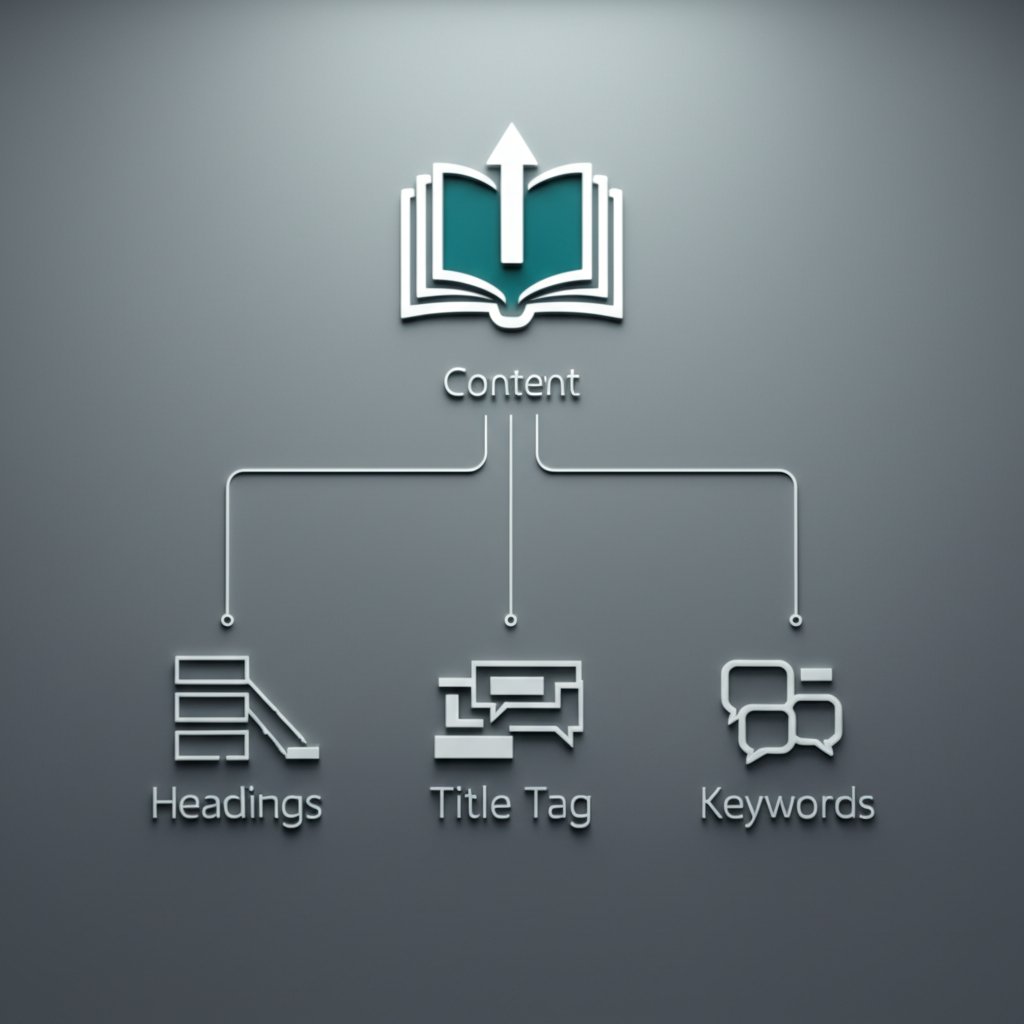TL;DR
To improve SEO, focus on three core areas: creating high-quality, relevant content that answers user questions, optimizing your website’s technical performance for speed and mobile-friendliness, and building authority through credible backlinks from other reputable sites. A successful strategy combines these on-page, technical, and off-page elements to increase your visibility and ranking in search engine results.
Foundational On-Page SEO: Content and Keywords
On-page SEO refers to the practice of optimizing individual web pages to rank higher and earn more relevant traffic. This is the foundation of any successful effort to improve SEO. According to Google's SEO Starter Guide, creating compelling and useful content is likely to influence your website more than any other factor. It begins with understanding what your audience is searching for and creating content that directly addresses their needs.
The process starts with keyword research. Think about the terms your potential visitors might use. A seasoned expert might search for "charcuterie," while a beginner might look for "cheese board." Anticipating these variations helps you craft content that serves a wider audience. Once you've identified your target keywords, they should be integrated naturally into key areas of your page. This includes the page title, headings, and the body of the content itself. However, the priority should always be readability and user experience; never sacrifice good writing for the sake of stuffing keywords.
A well-structured page is also crucial for both users and search engines. Use a clear hierarchy with headings (H1, H2, H3) to organize your content and make it scannable. Your primary keyword should ideally appear in your main title (H1), and related terms can be used in subheadings (H2, H3). Furthermore, elements like meta descriptions—the short text snippets that appear in search results—provide a vital opportunity to convince users to click. A compelling meta description should be unique, concise, and accurately summarize the page's value.
Follow these steps to establish a strong on-page SEO foundation:
- Conduct Keyword Research: Identify the terms and phrases your audience uses to find content like yours.
- Create Authoritative Content: Write unique, helpful, and well-organized content that fully answers the user's query. Incorporate firsthand experience to build trust and demonstrate expertise.
- Optimize Title Tags and Meta Descriptions: Write clear, compelling titles and descriptions that include your primary keyword and encourage clicks.
- Use Headings Strategically: Structure your content with H1, H2, and H3 tags to create a logical hierarchy and improve readability.
- Add Descriptive Alt Text to Images: Write clear alt text for all images to make your site more accessible and help search engines understand the visual content.
Technical SEO Enhancements for Better Performance
Technical SEO involves optimizing your website's infrastructure to help search engine spiders crawl and index your site more effectively. A technically sound website provides a better user experience, which is a critical factor for ranking well. If search engines can't properly access, understand, or render your content, your on-page efforts will be wasted. Key areas of focus include site speed, mobile-friendliness, and a clean site structure.
Page speed is a confirmed ranking factor. A slow-loading website leads to high bounce rates and frustrates users. You can use tools like Google PageSpeed Insights to analyze your site's performance and get recommendations for improvement. Common fixes include compressing images, leveraging browser caching, and minimizing server response time. These optimizations ensure that visitors can access your content quickly and smoothly.
With the majority of searches happening on mobile devices, mobile-friendliness is non-negotiable. Your website must be responsive, meaning it adapts seamlessly to different screen sizes. A poor mobile experience can severely damage your rankings and alienate a large portion of your audience. Finally, a logical site structure with clean, descriptive URLs helps both users and search engines navigate your site. For instance, a URL like `example.com/services/seo-consulting` is far more effective than `example.com/page-id=123`.
Use this checklist for a basic technical SEO audit:
- Check Site Speed: Use a tool like PageSpeed Insights to identify and fix performance bottlenecks.
- Ensure Mobile-Responsiveness: Test your site on various devices to confirm a flawless user experience.
- Submit a Sitemap: Provide a sitemap to Google Search Console to help it discover and index all your important pages.
- Fix Broken Links: Regularly check for and repair broken links (404 errors) to improve user experience and crawlability.
- Use Clean URLs: Make sure your URLs are short, descriptive, and include relevant keywords.

Building Authority with Off-Page SEO and Link Building
Off-page SEO refers to actions taken outside of your own website to impact your rankings. The most significant component of off-page SEO is link building. High-quality backlinks from reputable, relevant websites act as "votes of confidence" or endorsements. When an authoritative site links to your content, it signals to search engines that your page is a valuable and trustworthy resource, which can significantly improve your SEO.
However, not all links are created equal. The goal is to earn links from sites with high domain authority within your niche. A single link from a well-respected industry publication is far more valuable than dozens of links from low-quality, irrelevant directories. One of the most effective ways to earn these links is by creating what Backlinko calls "linkable assets." These are pieces of content so valuable and unique that other people naturally want to reference and link to them.
Examples of linkable assets include original research, in-depth data studies, free online tools, or comprehensive guides that are superior to anything else available. For instance, publishing a study with original data on a trend in your industry provides a resource that journalists, bloggers, and other creators can cite in their own work, generating high-quality backlinks for you. This strategy shifts the focus from actively asking for links to creating content that earns them organically.
Consider these actionable strategies for building authority:
- Create Linkable Assets: Develop original research, a unique tool, or a definitive guide that serves as a go-to resource in your industry.
- Guest Post on Reputable Blogs: Write articles for other well-regarded websites in your niche to gain exposure and earn a relevant backlink.
- Use Broken Link Building: Find broken links on other websites and suggest your relevant content as a replacement. This provides value to the site owner while earning you a link.
- Promote Your Content: Share your best content on social media and with relevant communities to increase its visibility and the likelihood of it being linked to.
Content Strategy: Regular Updates and Gaining an Edge
A successful SEO strategy doesn't end after you publish a piece of content. Search engines favor websites that are active and provide fresh, up-to-date information. Regularly updating your existing content is a powerful way to improve SEO, often yielding significant results with less effort than creating a new article from scratch. As noted by several sources, including Michigan Technological University, this signals to search engines that your site is relevant and well-maintained.
One advanced technique is to use Google Search Console (GSC) to identify content refresh opportunities. By analyzing the "Queries" report for a specific page, you can find keywords that your page is getting impressions for but doesn't rank highly for. Updating your content to better target these terms can lead to quick ranking improvements. This data-driven approach ensures your updates are strategic and impactful.
To truly stand out, focus on providing "Information Gain." This concept involves adding unique value, perspectives, or data that can't be found in other top-ranking pages. With the rise of AI-generated content, adding firsthand experience, original case studies, or custom visuals is more important than ever. This not only differentiates your content for users but also makes it a more valuable asset in the eyes of search engines. For marketers and creators looking to scale this process, tools can help streamline the workflow. For instance, an AI blog post generator like BlogSpark can help transform ideas into SEO-optimized drafts, freeing up teams to focus on adding unique insights and strategic value. You can explore how it works by visiting https://blogspark.ai/.
Follow this step-by-step process for a content refresh:
- Identify an Opportunity: In Google Search Console, find a page with high impressions but a low click-through rate.
- Analyze Queries: Review the keywords the page is getting impressions for. Note any relevant terms you aren't fully targeting.
- Update and Enhance: Revise the content to incorporate these keywords. Add new, relevant information, such as recent data, personal experiences, or new examples.
- Add New Visuals: Include new images, charts, or videos to make the content more engaging and informative.
- Republish and Re-index: Update the publication date and request that Google re-index the page through Search Console.
Putting It All Together for Lasting SEO Success
Improving your SEO is not a one-time task but an ongoing process of refinement and adaptation. The digital landscape is constantly evolving, but the core principles remain consistent. Success hinges on a balanced approach that prioritizes high-quality content, a flawless technical foundation, and a strong authoritative presence. By focusing on creating value for your users, you align your goals with those of search engines.
Start by building a solid foundation with well-researched, expertly written on-page content. Ensure your website is fast, secure, and accessible on all devices. From there, build your site's credibility by earning high-quality backlinks. Finally, treat your content as a living asset, regularly updating and enhancing it to keep it fresh and valuable. By consistently applying these strategies, you can achieve sustainable growth in your search engine rankings and attract more of the right audience to your website.

Frequently Asked Questions About SEO
1. What does "improve SEO" mean?
Improving SEO, or Search Engine Optimization, is the process of making enhancements to your website to increase its visibility when people search for products or services related to your business in search engines like Google. The goal is to improve your website's position in the search results pages. A higher ranking means more people are likely to see and visit your site, leading to increased traffic and potential customers.
2. What is the 80/20 rule for SEO?
The 80/20 rule for SEO, also known as the Pareto Principle, suggests that approximately 80% of your organic traffic and ranking results come from just 20% of your SEO efforts. This principle helps you prioritize tasks by focusing on the highest-impact activities. For example, creating one exceptional piece of content that becomes a linkable asset or fixing a major technical issue might yield far greater results than dozens of minor tweaks.




